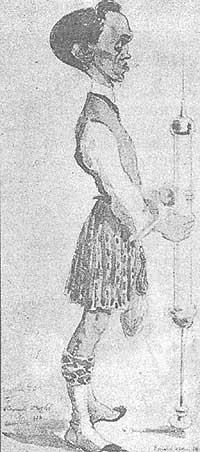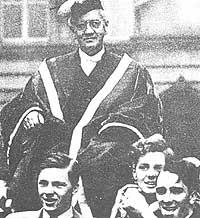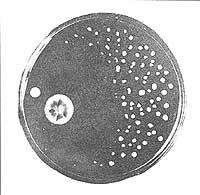Penicilinas sixty years
1988/10/01 Juandaburre, B. Iturria: Elhuyar aldizkaria

Most know Alexander Fleming and that he was also discoverer of penicillin. Because of the facilities that penicillin has created to cure and treat various diseases suffered by our grandparents, it is not strange that Fleming is up to the myth. From the very moment the myth arises, many things have been said and published about Fleming and many are too false or false. To mention a few: after saving Wiston Churchill from drowning as a young man in a pool, his parents thanked him for having paid for medical studies; he had to fight his peers to get the penicillin forward; he found penicillin in 1940, when he fell on crops in which the dust raised by a bomb thrown in London had fallen; or he isolated his penicillin Florwey.
Who was Alexander Fleming and how did he find penicillin?
Fleming was the son of a Scottish peasant. He was born in Loudou on 6 August 1881. When he was fourteen, he went to London to visit his brother doctor and started working there in a sailing company. Thanks to a small heritage he studied medicine at St. Mary Hospital in London, where he won all the studies and scholarship awards. He completed his studies in 1906 and joined the Inoculation Department, led by Almroth Wright. There he spent more than forty years. Wright and his colleagues worked to treat bacterial diseases through vaccines. The sale of vaccines was also the most important financial source of the Department. Fleming became one of the team's most enthusiastic members and demonstrated his skills by developing new methods and tools. In addition, he was very skilled in treating syphilis with the new drug called salvarsan.
During World War I he worked with Wright in a field hospital in Boulogne, working on the pavements of wounds. His work found that the antiseptics being used were inadequate and Fleming prepared a test to test new antiseptics. Fleming did a very nice job.
In 1921 he discovered a protein called lysozyme. This protein has a bacteriolytic effect, that is, it has the ability to destroy bacteria. It seems that this discovery did so by chance. During the cultivation of its mucus, it was contaminated by a very accustomed organism. Fleming discovered that the colonies of this organism were destroyed near the mucus. Fleming worked very well on lysozyme (perhaps the brightest work he did), but it was unattractive because lysozyme barely affected pathogenic organisms.
Seven years later, in 1928, Fleming discovered penicillin. The process of this discovery seems a clear example of the discovery of lysozyme. It is not clear when the discovery occurred because it is not written in Fleming's notebook. It seems that when Fleming returned on vacation, it occurred on September three or four. On his table he had left some growing dishes before going on vacation. Some of them were shot down and others were kept to show a visitor. Looking a second time at one of the latter, he discovered that along with a mold stain, the staph colonies were destroyed.

In his notebook the first session on mold dates from 30 October. A mold colony grew and began to study the behavior of several organisms with it. Some of them grew to the base of the mold, but staphylococcus remained 2.5 cm from the mold. He did other sessions with staphylococcus and wrote: mold culture contains a bactericidal substance to staphylococcus.
Between January and April 1929, Fleming and his collaborators Ridley and Craddock analyzed the efficacy of the substance called penicillin. He was called penicillin because mold was penicilium. Penicillin, which prevented the growth of many pathogenic organisms, also observed that it was not toxic to living cells. Against general antiseptic fleming. He seemed to have fulfilled the dream of his life. But unfortunately this did not happen. They soon lost hope. In the sessions held, it was detected that penicillin took more than four hours to kill bacteria and also, in the presence of blood sero, lost most of its activity. When the rabbits were put to life, in 30 minutes it disappeared from the blood. Fleming thought that continuing to work with penicillin was wasting time. Perhaps that is why he did not do the decisive animal protection test. The true strength of penicillin that would have taught him and Fleming did not realize the real importance of his discovery.
In May 1929 Fleming sent to publish his report on penicillin. He mentioned the antiseptic effect of penicillin, but did not do it enough. At present, the original "separates" of that article, 300,000 pesetas. around.
Fleming apparently lost interest in penicillin. From 1930 to 1940 he published 27 articles dedicated exclusively to penicillin, which studied its use for the production of selective crops. During these ten years Fleming used penicillin in traditional vaccine production for sale. He did not investigate further and showed no interest in penicillin research.
The penicillin boom comes mainly from the work of an Oxford group. The work began in 1938, when Ernt Chain was conducting a bibliographic research on natural bactericidal agents and learned about Fleming's report. Chain was a chemist and had an interest in the world of enzymes. When he starts testing penicillin, he realizes his bactericidal strength and decides to do an animal protection test by contacting Florey. The test was conducted on 25 May 1940 and the results were very positive. The tests and results that were performed on people throughout 1941 were admirable.
The publication of the results of this work did not generate interest. Nor did it affect him much. He wrote that penicillin could be replaced by sulfonamide if it was synthesized.

Interest in Fleming penicillin rose in August 1942, when a friend became ill with meningitis. The sulfonamides were ineffective and when his friend was about to die, Fleming decided to try penicillin. He called Florey and asked him to explain how to use penicillin. The dying patient recovered quickly.
As a result and thanks to a letter sent by Almroth Wright, his advisor, to The Times, in which all the merit of penicillin was attributed to Fleming, Fleming was involved in a large advertising campaign. Until his death in 1955, he was a favorite character for the hero and the world press.
The causes of disproportionate diffusers are complex. One of them is Florey's harsh attitude to the press, because he did not want publicity. The journalists then rejected him. Another thing was the attitude of St. Mary's hospital in which Fleming worked. Journalists were accepted there. In addition, the dean of St. Mary, Churchill's physician, reinforced the press campaign. In 1942 the British government needed something to reinforce the morale of the population in the midst of the war. A fascinating drug like penicillin was an unbeatable opportunity to undertake this work. The Minister of Information launched a campaign on penicillin. Fleming was the character everyone wanted to meet and the press considered him a beloved child. The Oxford team was out of all this.
However, the Nobel Prize committee was able to raise more than journalists and awarded the 1944 Nobel Prize to Florey, Chain and Fleming.
Fleming is a good bacteriologist and competent who did great work, but in this topic penicillin received a disproportionate fame. Therefore, the intention of these lines has been to show the real image of this well-known scientist.

Gai honi buruzko eduki gehiago
Elhuyarrek garatutako teknologia




